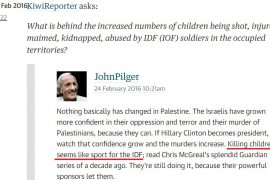1) The ITIC provides ‘Evidence of the terrorist organizations’ use of civilian facilities in the Gaza Strip’.
“Firing rockets and mortar shells from within population centers and public institutions such as hospitals and schools, and placing military facilities in or near them, are a well-known modus operandi used by Hamas and other terrorist organizations. Its objective is to protect Hamas operatives from IDF responses and increase their chances of survival. Claims and documentation of the use of Palestinian terrorist organizations, including Hamas, against the civilian population were raised as early as 2006. According to an article by the NATO Strategic Communications Centre of Excellence, Hamas has been using the civilian population as human shields in conflicts with Israel since 2007.”
2) At WINEP, Hanin Ghaddar and Matthew Levitt analyse the elimination of Saleh al Arouri.
“Arouri celebrated the October 7 Hamas massacre that killed some 1,200 Israelis, including around 850 civilians, and in recent years he invested significant time and effort to build up a Hamas terrorist capability in Lebanon. A hardliner who long pushed for increased violence in the West Bank, over the past couple of years Arouri also participated in coordination meetings involving Hamas, Hezbollah, and Iran’s Islamic Revolutionary Guard Corps (IRGC) at their “joint war room” in Beirut. Within Hamas, Arouri was an old rival of Yahya al-Sinwar, the Hamas chief in Gaza who masterminded the October 7 attack, and a leading contender to be the group’s next overall leader.”
3) At the Alma Center, Sarit Zehavi and Tal Beeri discuss the implications of recent attacks against UNIFIL in Lebanon.
“Since the outbreak of war in the Gaza Strip in October 2023 and Hezbollah’s military involvement against Israel, there have been, as of this writing, three incidents in which UNIFIL forces were attacked in southern Lebanon. Attacks against UNIFIL are a recognized phenomenon that predates October 2023. UNIFIL forces were attacked from time to time in southern Lebanon, particularly when they entered regions where Hezbollah did not want them to be.”
4) At the JCPA, Khaled Abu Toameh looks at the options of Hamas’ leader in the Gaza Strip.
“In May 2021, Hamas leader Yahya Sinwar responded to Israeli threats to assassinate him and other commanders of his Iran-backed terror group, saying that he was not afraid of death: “The biggest gift they [Israel] can give me is to assassinate me. They know where I live, and I’m waiting for them.”
Since Hamas’s October 7, 2023, attack on Israel, however, Sinwar, one of the masterminds of the massacre, has gone into hiding. He is no longer waiting for the Israeli troops to show up at his home.”
5) At Commentary magazine, Seth Mandel addresses ‘The Hamasification of the Red Cross’.
“There is no such thing as an “international” organization in Gaza. There is only international funding. Once you understand that, you can see the conflict much more clearly. Once in Gaza, everything is an adjunct of Hamas.”
6) At Newsweek, Hamza Howidy writes about dissent under the Hamas regime.
“Voicing dissent was not an option. Hamas has a no tolerance policy for criticism or objections to any of its policies. Even discussion is forbidden Any journalist who objects or criticizes a policy is suspended and investigated. Demonstrations are strictly prohibited. Freedom of speech in Gaza is a fantasy. The dirtiest tool Hamas uses to silence citizens is character assassination through online campaigns accusing dissenters of working for hostile bodies or committing immoral acts. Hamas also routinely breaks into the homes of people deemed disloyal and humiliates them in front of their family and neighbors.”




